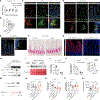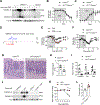Epithelial STAT6 O-GlcNAcylation drives a concerted anti-helminth alarmin response dependent on tuft cell hyperplasia and Gasdermin C
- PMID: 35385697
- PMCID: PMC9109499
- DOI: 10.1016/j.immuni.2022.03.009
Epithelial STAT6 O-GlcNAcylation drives a concerted anti-helminth alarmin response dependent on tuft cell hyperplasia and Gasdermin C
Erratum in
-
Epithelial STAT6 O-GlcNAcylation drives a concerted anti-helminth alarmin response dependent on tuft cell hyperplasia and Gasdermin C.Immunity. 2022 Jul 12;55(7):1327. doi: 10.1016/j.immuni.2022.06.011. Immunity. 2022. PMID: 35830826 Free PMC article. No abstract available.
Abstract
The epithelium is an integral component of mucosal barrier and host immunity. Following helminth infection, the intestinal epithelial cells secrete "alarmin" cytokines, such as interleukin-25 (IL-25) and IL-33, to initiate the type 2 immune responses for helminth expulsion and tolerance. However, it is unknown how helminth infection and the resulting cytokine milieu drive epithelial remodeling and orchestrate alarmin secretion. Here, we report that epithelial O-linked N-Acetylglucosamine (O-GlcNAc) protein modification was induced upon helminth infections. By modifying and activating the transcription factor STAT6, O-GlcNAc transferase promoted the transcription of lineage-defining Pou2f3 in tuft cell differentiation and IL-25 production. Meanwhile, STAT6 O-GlcNAcylation activated the expression of Gsdmc family genes. The membrane pore formed by GSDMC facilitated the unconventional secretion of IL-33. GSDMC-mediated IL-33 secretion was indispensable for effective anti-helminth immunity and contributed to induced intestinal inflammation. Protein O-GlcNAcylation can be harnessed for future treatment of type 2 inflammation-associated human diseases.
Keywords: Gasdermin; IL-10; IL-25; IL-33; O-GlcNAc; OGT; STAT6; Tuft cell; colitis; goblet cell.
Copyright © 2022 Elsevier Inc. All rights reserved.
Conflict of interest statement
Declaration of interests The authors disclose no conflicts.
Figures







Comment in
-
Expelliarmus helminthus! Harry Helminth and the Goblet of Alarmins.Immunity. 2022 Apr 12;55(4):575-577. doi: 10.1016/j.immuni.2022.03.014. Immunity. 2022. PMID: 35417668
References
-
- Bach JF (2018). The hygiene hypothesis in autoimmunity: the role of pathogens and commensals. Nat Rev Immunol 18, 105–120. - PubMed
MeSH terms
Substances
Grants and funding
LinkOut - more resources
Full Text Sources
Molecular Biology Databases
Research Materials
Miscellaneous

